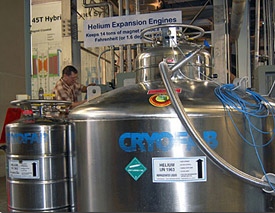
Liquid helium keeps our 45 tesla hybrid at about -456 degrees Fahrenheit (-271 degrees Celsius).
Cryogenics is the field of endeavor that has the purpose of making something very cold from about 100 degrees Kelvin to absolute zero. The big thing that happens when it becomes cryogenic is it becomes a liquid. For example, liquid nitrogen, which is the most abundant and common cryogen, boils at a temperature of 77 degrees Kelvin, which is -320 degrees Fahrenheit, -195 degrees Celsius, so it's very cold, much colder than any place on Earth. Liquid helium boils at 4 degrees Kelvin. Now, why do we use cryogenics at the Magnet Lab? It's used almost exclusively for cooling of superconducting magnets. It is necessary, in order for superconducting materials to function, for them to be very cold. A lot of the research in this lab uses cryogenics also because we're trying to study the behavior of materials at the extremes of parameter space and one of the extremes that we can achieve is low temperatures.


